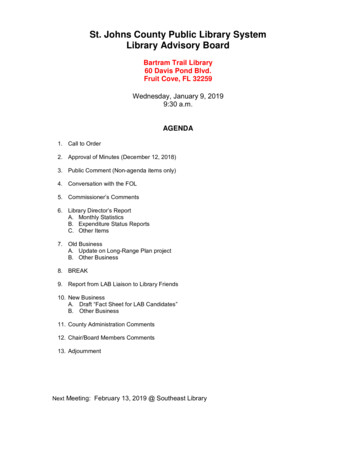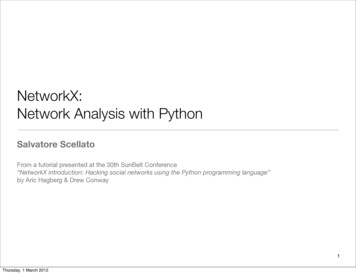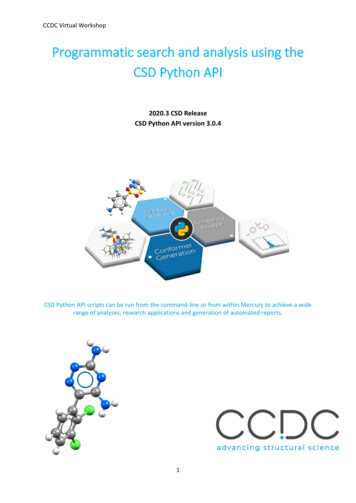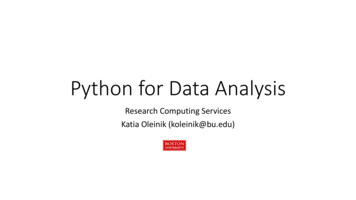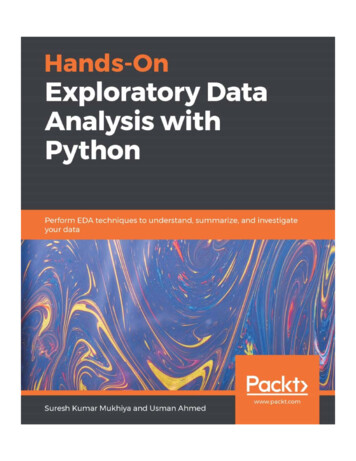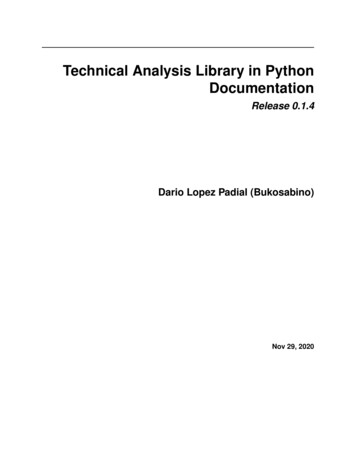
Transcription
Technical Analysis Library in PythonDocumentationRelease 0.1.4Dario Lopez Padial (Bukosabino)Nov 29, 2020
CONTENTS1Installation (python v3.6)32Examples53Motivation74Contents4.1 Documentation . . . . . . . . . . . . . . . . . . . . . . . . . . . . . . . . . . . . . . . . . . . . . .995Indices and tables61Python Module Index63Index65i
ii
Technical Analysis Library in Python Documentation, Release 0.1.4It is a Technical Analysis library to financial time series datasets (open, close, high, low, volume). You can use it to dofeature engineering from financial datasets. It is builded on Python Pandas library.CONTENTS1
Technical Analysis Library in Python Documentation, Release 0.1.42CONTENTS
CHAPTERONEINSTALLATION (PYTHON V3.6) virtualenv -p python3 virtualenvironment source virtualenvironment/bin/activate pip install ta3
Technical Analysis Library in Python Documentation, Release 0.1.44Chapter 1. Installation (python v3.6)
CHAPTERTWOEXAMPLESExample adding all features:import pandas as pdfrom ta import add all ta featuresfrom ta.utils import dropna# Load datasdf pd.read csv('ta/tests/data/datas.csv', sep ',')# Clean NaN valuesdf dropna(df)# Add ta features filling NaN valuesdf add all ta features(df, open "Open", high "High", low "Low", close "Close", volume "Volume BTC", fillna True)Example adding a particular feature:import pandas as pdfrom ta.utils import dropnafrom ta.volatility import BollingerBands# Load datasdf pd.read csv('ta/tests/data/datas.csv', sep ',')# Clean NaN valuesdf dropna(df)# Initialize Bollinger Bands Indicatorindicator bb BollingerBands(close df["Close"], window 20, window dev 2)# Add Bollinger Bands featuresdf['bb bbm'] indicator bb.bollinger mavg()df['bb bbh'] indicator bb.bollinger hband()df['bb bbl'] indicator bb.bollinger lband()# Add Bollinger Band high indicatordf['bb bbhi'] indicator bb.bollinger hband indicator()# Add Bollinger Band low indicatordf['bb bbli'] indicator bb.bollinger lband indicator()5
Technical Analysis Library in Python Documentation, Release 0.1.46Chapter 2. Examples
CHAPTERTHREEMOTIVATION English: b2b390d3543 f9427d07
Technical Analysis Library in Python Documentation, Release 0.1.48Chapter 3. Motivation
CHAPTERFOURCONTENTS4.1 DocumentationIt is a Technical Analysis library useful to do feature engineering from financial time series datasets (Open, Close,High, Low, Volume). It is built on Pandas and Numpy.4.1.1 Momentum IndicatorsMomentum Indicators.class ta.momentum.AwesomeOscillatorIndicator(high: pandas.core.series.Series, low: pandas.core.series.Series, window1: int 5,window2: int 34, fillna: bool False)Awesome OscillatorFrom: https://www.tradingview.com/wiki/Awesome Oscillator (AO)The Awesome Oscillator is an indicator used to measure market momentum. AO calculates the difference of a34 Period and 5 Period Simple Moving Averages. The Simple Moving Averages that are used are not calculatedusing closing price but rather each bar’s midpoints. AO is generally used to affirm trends or to anticipate possiblereversals.From: llatorAwesome Oscillator is a 34-period simple moving average, plotted through the central points of the bars(H L)/2, and subtracted from the 5-period simple moving average, graphed across the central points of thebars (H L)/2.MEDIAN PRICE (HIGH LOW)/2AO SMA(MEDIAN PRICE, 5)-SMA(MEDIAN PRICE, 34)whereSMA — Simple Moving Average.Parameters high (pandas.Series) – dataset ‘High’ column. low (pandas.Series) – dataset ‘Low’ column. window1 (int) – short period. window2 (int) – long period. fillna (bool) – if True, fill nan values with -50.9
Technical Analysis Library in Python Documentation, Release 0.1.4awesome oscillator() pandas.core.series.SeriesAwesome OscillatorReturns New feature generated.Return type pandas.Seriesclass ta.momentum.KAMAIndicator(close: pandas.core.series.Series, window: int 10, pow1: int 2, pow2: int 30, fillna: bool False)Kaufman’s Adaptive Moving Average (KAMA)Moving average designed to account for market noise or volatility. KAMA will closely follow prices when theprice swings are relatively small and the noise is low. KAMA will adjust when the price swings widen andfollow prices from a greater distance. This trend-following indicator can be used to identify the overall trend,time turning points and filter price arameters close (pandas.Series) – dataset ‘Close’ column. window (int) – n period. pow1 (int) – number of periods for the fastest EMA constant. pow2 (int) – number of periods for the slowest EMA constant. fillna (bool) – if True, fill nan values.kama() pandas.core.series.SeriesKaufman’s Adaptive Moving Average (KAMA)Returns New feature generated.Return type pandas.Seriesclass .core.series.Series, window slow: int 26, window fast: int 12,window sign: int 9, fillna: bool False)The Percentage Price Oscillator (PPO) is a momentum oscillator that measures the difference between twomoving averages as a percentage of the larger moving average.https://school.stockcharts.com/doku.php?id technical indicators:price oscillators ppoParameters close (pandas.Series) – dataset ‘Price’ column. window slow (int) – n period long-term. window fast (int) – n period short-term. window sign (int) – n period to signal. fillna (bool) – if True, fill nan values.ppo()Percentage Price Oscillator LineReturns New feature generated.Return type pandas.Seriesppo hist()Percentage Price Oscillator HistogramReturns New feature generated.10Chapter 4. Contents
Technical Analysis Library in Python Documentation, Release 0.1.4Return type pandas.Seriesppo signal()Percentage Price Oscillator Signal LineReturns New feature generated.Return type pandas.Seriesclass ta.momentum.PercentageVolumeOscillator(volume: pandas.core.series.Series, window slow: int 26, window fast: int 12,window sign: int 9, fillna: bool False)The Percentage Volume Oscillator (PVO) is a momentum oscillator for volume. The PVO measures the difference between two volume-based moving averages as a percentage of the larger moving average.https://school.stockcharts.com/doku.php?id technical indicators:percentage volume oscillator pvoParameters volume (pandas.Series) – dataset ‘Volume’ column. window slow (int) – n period long-term. window fast (int) – n period short-term. window sign (int) – n period to signal. fillna (bool) – if True, fill nan values.pvo() pandas.core.series.SeriesPVO LineReturns New feature generated.Return type pandas.Seriespvo hist() pandas.core.series.SeriesHistgramReturns New feature generated.Return type pandas.Seriespvo signal() pandas.core.series.SeriesSignal LineReturns New feature generated.Return type pandas.Seriesclass ta.momentum.ROCIndicator(close: pandas.core.series.Series, window: int 12, fillna: bool False)Rate of Change (ROC)The Rate-of-Change (ROC) indicator, which is also referred to as simply Momentum, is a pure momentumoscillator that measures the percent change in price from one period to the next. The ROC calculation comparesthe current price with the price “n” periods ago. The plot forms an oscillator that fluctuates above and belowthe zero line as the Rate-of-Change moves from positive to negative. As a momentum oscillator, ROC signalsinclude centerline crossovers, divergences and overbought-oversold readings. Divergences fail to foreshadowreversals more often than not, so this article will forgo a detailed discussion on them. Even though centerlinecrossovers are prone to whipsaw, especially short-term, these crossovers can be used to identify the overall trend.Identifying overbought or oversold extremes comes naturally to the Rate-of-Change ?id technical indicators:rate of change roc and momentumParameters4.1. Documentation11
Technical Analysis Library in Python Documentation, Release 0.1.4 close (pandas.Series) – dataset ‘Close’ column. window (int) – n period. fillna (bool) – if True, fill nan values.roc() pandas.core.series.SeriesRate of Change (ROC)Returns New feature generated.Return type pandas.Seriesclass ta.momentum.RSIIndicator(close: pandas.core.series.Series, window: int 14, fillna: bool False)Relative Strength Index (RSI)Compares the magnitude of recent gains and losses over a specified time period to measure speed and change ofprice movements of a security. It is primarily used to attempt to identify overbought or oversold conditions inthe trading of an Parameters close (pandas.Series) – dataset ‘Close’ column. window (int) – n period. fillna (bool) – if True, fill nan values.rsi() pandas.core.series.SeriesRelative Strength Index (RSI)Returns New feature generated.Return type pandas.Seriesclass ta.momentum.StochRSIIndicator(close: pandas.core.series.Series, window: int 14,smooth1: int 3, smooth2: int 3, fillna: bool False)Stochastic RSIThe StochRSI oscillator was developed to take advantage of both momentum indicators in order to create amore sensitive indicator that is attuned to a specific security’s historical performance rather than a generalizedanalysis of price change.https://school.stockcharts.com/doku.php?id technical indicators:stochrsi arameters close (pandas.Series) – dataset ‘Close’ column. window (int) – n period smooth1 (int) – moving average of Stochastic RSI smooth2 (int) – moving average of %K fillna (bool) – if True, fill nan values.stochrsi()Stochastic RSIReturns New feature generated.Return type pandas.Series12Chapter 4. Contents
Technical Analysis Library in Python Documentation, Release 0.1.4stochrsi d()Stochastic RSI %dReturns New feature generated.Return type pandas.Seriesstochrsi k()Stochastic RSI %kReturns New feature generated.Return type pandas.Seriesclass pandas.core.series.Series, window:int 14,smooth window: int 3, fillna: bool False)Stochastic OscillatorDeveloped in the late 1950s by George Lane. The stochastic oscillator presents the location of the closing priceof a stock in relation to the high and low range of the price of a stock over a period of time, typically a hp?id technical indicators:stochastic oscillator fast slow and fullParameters close (pandas.Series) – dataset ‘Close’ column. high (pandas.Series) – dataset ‘High’ column. low (pandas.Series) – dataset ‘Low’ column. window (int) – n period. smooth window (int) – sma period over stoch k. fillna (bool) – if True, fill nan values.stoch() pandas.core.series.SeriesStochastic OscillatorReturns New feature generated.Return type pandas.Seriesstoch signal() pandas.core.series.SeriesSignal Stochastic OscillatorReturns New feature generated.Return type pandas.Seriesclass ta.momentum.TSIIndicator(close: pandas.core.series.Series, window slow: int 25, window fast: int 13, fillna: bool False)True strength index (TSI)Shows both trend direction and overbought/oversold ?id technical indicators:true strength indexParameters close (pandas.Series) – dataset ‘Close’ column. window slow (int) – high period.4.1. Documentation13
Technical Analysis Library in Python Documentation, Release 0.1.4 window fast (int) – low period. fillna (bool) – if True, fill nan values.tsi() pandas.core.series.SeriesTrue strength index (TSI)Returns New feature generated.Return type pandas.Seriesclass ries.Series,low:pandas.core.series.Series, close: pandas.core.series.Series,window1: int 7, window2: int 14, window3: int 28, weight1: float 4.0, weight2: float 2.0, weight3:float 1.0, fillna: bool False)Ultimate OscillatorLarry Williams’ (1976) signal, a momentum oscillator designed to capture momentum across three doku.php?id chart school:technical indicators:ultimate oscillatorBP Close - Minimum(Low or Prior Close). TR Maximum(High or Prior Close) - Minimum(Low or PriorClose) Average7 (7-period BP Sum) / (7-period TR Sum) Average14 (14-period BP Sum) / (14-period TRSum) Average28 (28-period BP Sum) / (28-period TR Sum)UO 100 x [(4 x Average7) (2 x Average14) Average28]/(4 2 1)Parameters high (pandas.Series) – dataset ‘High’ column. low (pandas.Series) – dataset ‘Low’ column. close (pandas.Series) – dataset ‘Close’ column. window1 (int) – short period. window2 (int) – medium period. window3 (int) – long period. weight1 (float) – weight of short BP average for UO. weight2 (float) – weight of medium BP average for UO. weight3 (float) – weight of long BP average for UO. fillna (bool) – if True, fill nan values with 50.ultimate oscillator() pandas.core.series.SeriesUltimate OscillatorReturns New feature generated.Return type pandas.Seriesclass ries.Series,low:pandas.core.series.Series, close: pandas.core.series.Series,lbp: int 14, fillna: bool False)Williams %RDeveloped by Larry Williams, Williams %R is a momentum indicator that is the inverse of the Fast StochasticOscillator. Also referred to as %R, Williams %R reflects the level of the close relative to the highest high for thelook-back period. In contrast, the Stochastic Oscillator reflects the level of the close relative to the lowest low.%R corrects for the inversion by multiplying the raw value by -100
Technical Analysis Library in Python Documentation, Release 0.1.4 It is a Technical Analysis library to financial time series datasets (open, close, high, low, volume).




